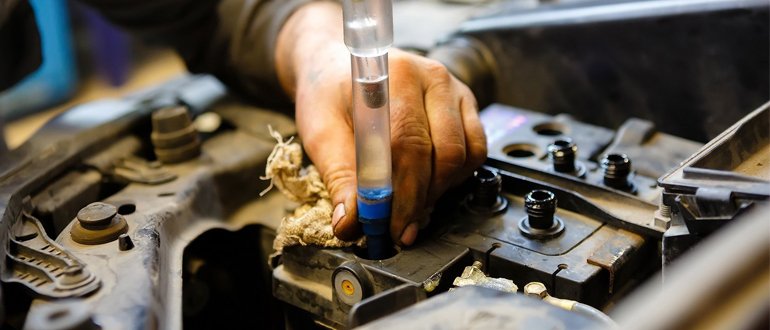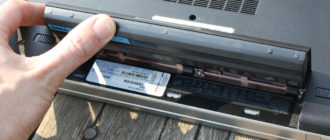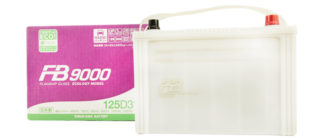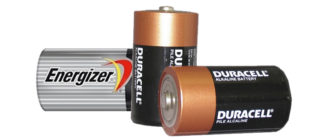An electrolyte is a mixture of sulfuric acid and distilled water. It is not an integral component of any battery. It is very important to monitor its condition and level and, if necessary, top up or change. Otherwise, the battery may malfunction.
Content
Why do I need electrolyte in the battery?
In lead-acid batteries, electrochemical processes take place that produce electricity. These processes are possible only with the direct participation of the electrolyte.
The battery has negative and positively charged plates. They include lead down conductors. They can have various additives on which the type of battery depends.
Depending on the density of the electrolyte, the degree of charge of the battery depends. If it is increased, the battery will be recharged, and an aggressive environment in general can harm the battery. When it is lowered, the battery will be discharged. The concentration of concentrated acid for the battery is 1.835. In order to lead to a normal rate, it is necessary to use distilled water.
The range of indicators of a normally charged battery is in the range 1.23 - 1.25 g / cm3. When the engine starts, the audio and light elements are turned on, the battery is discharged. This is due to the occurrence of an electrochemical reaction. The substance loses sulfuric acid, resulting in a drop in density and battery discharge.
How much electrolyte should be in the battery
The car owner must constantly monitor the electrolyte level. If it drops, it will be necessary to add distilled water. The volume of the mixture will depend on the capacity of the battery:
- 55 Ah - 2.5 L;
- 60 Ah - 2.7-3 l;
- 62 Ah - about 3 liters;
- 65 Ah - about 3.5 liters;
- 75 Ah - 3.7-4 l;
- 90 Ah - 4.4-4.8 L;
- 190 Ah - about 10 liters.
Depending on the manufacturer, technology and model, these figures may vary, so they are conditional. The main thing to remember is that the electrolyte should completely cover the plates by 10-15 mm and in no case should they protrude.

How to check the electrolyte level in the battery
Most battery banks have a scale with a value of MIN and MAX in this range should be the electrolyte. There are models with plastic tabs under the corks that go down into the cans, they should be immersed in the liquid by 5 mm.
Modern batteries are equipped with a special sensor on the housing, which indicates a low level of electrolyte and the degree of battery drain.
If for some reason there are no signs, then you can resort to the following method:
- Take not a big clean tube;
- We wipe the battery case clean and dry;
- Unscrew the lids from all the cans;
- At a right angle, lower the tube into the jar and touch its plates;
- Firmly pinch the upper hole of the tube with a finger;
- Carefully pull out and measure the height of the liquid (should be at the level of 10-15 mm);
- Repeat the procedure with all the banks.
If the jars do not have enough mixture, then you will need to add distilled water. You need to top up until the plates are completely closed. Distilled water can be bought at the pharmacy. You can not fill in ordinary tap water.
If you operate a car with "bare plates", then they will quickly crumble and fall apart.
The market now has maintenance free batteries.If there are no covers on the case, then water cannot be added to it.
Why electrolyte levels can drop
If the battery is not hermetically sealed, then the liquid slowly evaporates and boils away. Therefore, it is periodically required to add distilled water.
Also, when charging, the mixture always boils, so after each charge it is recommended to measure the electrolyte level. First you need to wait until the electrolyte stops boiling.
What you can add water or electrolyte to the battery
If the battery plates are not closed, then the substance level is not high enough and distilled water must be added. At the same time, you can’t fill in plain water, since there are various impurities in it that can disrupt the operation of the battery and disable it.
If the mixture has a sufficient density, then distilled water is added. If a electrolyte density approaching the lower mark, then you can add the alkaline mixture. When current flows through the battery, acid consumption occurs. The process is called H2SO4 diffusion between the volume and the electrode. This is how voltage is maintained at the battery terminals.
What to do if low electrolyte
In the event of a drop in electrolyte level, it will need to be added. To begin with, it is worth pouring distilled water and putting the battery on charge. If the density does not begin to rise, then you can try to drain all the liquid and completely replace the electrolyte.
Sometimes the battery is discharged to such an extent that topping up a new mixture may not be practical. If the element did not last long, then you can do this procedure. But this does not always work on older batteries. They become unusable if they are operated on an electrolyte with a low alkaline level.
Still have questions about electrolyte level or have something to add? Then write to us about it in the comments, this will make the material more useful, complete and accurate.









